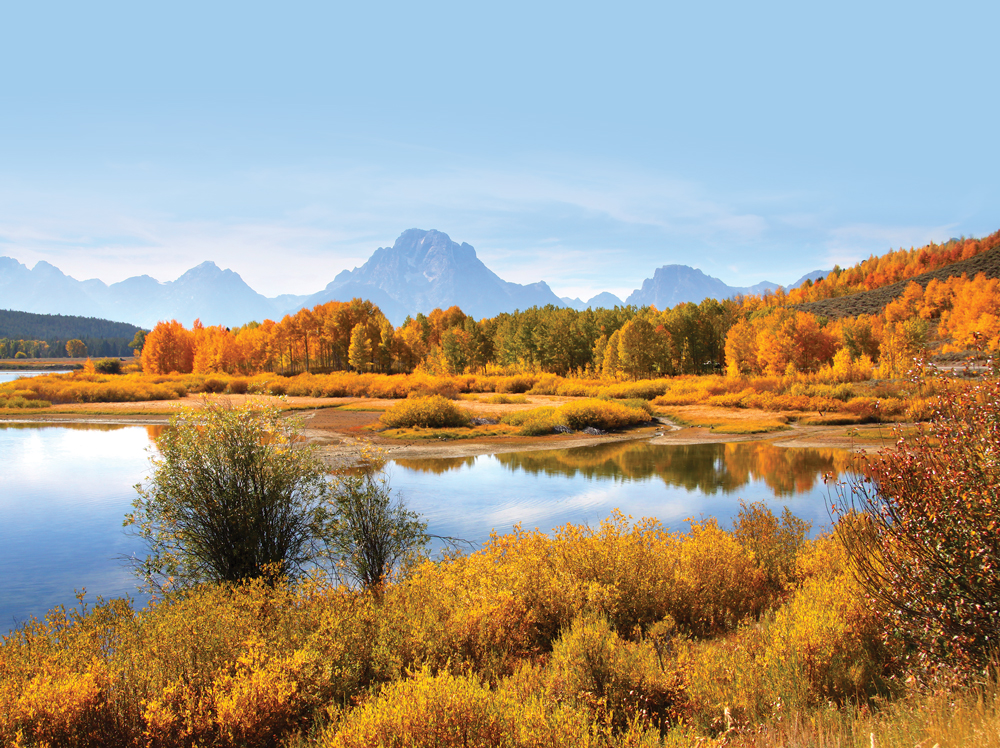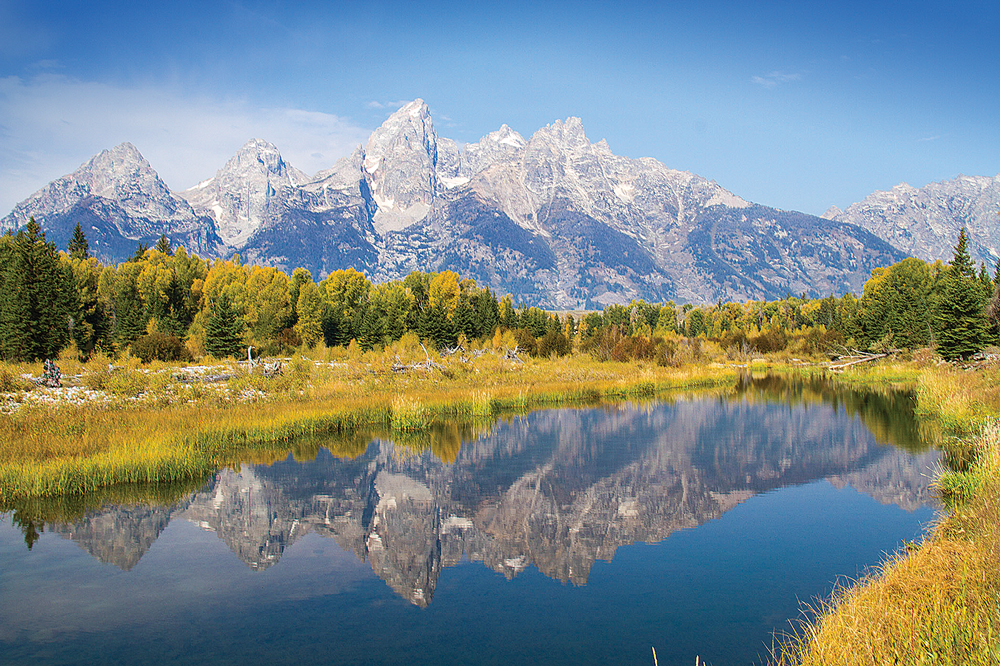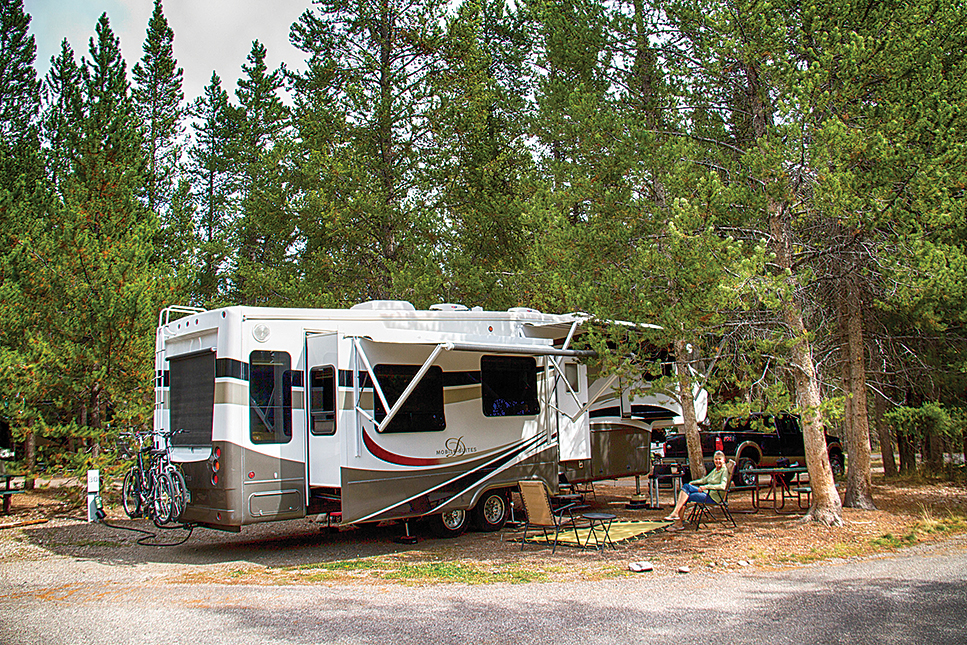Northwestern Wyoming’s impressive “mountains of the imagination” paint a grand backdrop for the meandering Snake River and fall’s dazzling kaleidoscope of deciduous trees
“What beautiful mountains these are,” I exclaimed to my wife, as we drove down U.S. Highway 191 in Wyoming through Grand Teton National Park many years ago after spending two weeks in Yellowstone. We did little more than pass through this area because the highway was the major north-south thoroughfare through northwestern Wyoming. It didn’t even seem like we were in a national park at the time. While we did make a few random stops, we did not give this park its just due or even see the main highlights. It wasn’t until our extended stay last September that we truly learned to appreciate this majestic gem of the Rocky Mountains.

Christian Pond near Oxbow Bend reflects
spectacular mountains and changing colors. Once winter is over, the shallow pool warms up and attracts many types of wildlife that include a variety of birds and moose.
Grand Teton National Park was created in 1929 and completed with a major land donation from John D. Rockefeller Jr. in 1950. The 310,000 acres of the park provide ample opportunities for a variety of outdoor activities, and visitors can view the very jagged peaks and deep canyons in this range of mountains. Aspen groves and lodgepole pine forests mantle the peaks, and glacial activity created many scenic alpine lakes. Wildlife is abundant, and we were privileged to see moose, deer, elk, fox, buffalo, eagles and ospreys. As a bonus, we were blessed with exceptional autumn colors.
For our first visit to the park, we were ill prepared to really understand what was available to see. We highly advise making use of the visitor centers before beginning your adventure. The first center we stopped at was designed to provide information on the entire national park region of northwestern Wyoming. Jackson Hole, the valley floor between the Teton Range and the Snake River, has a large and colorful visitor center complete with several dioramas. Located on the north end of Jackson on the main highway, the complex is well worth a stop. You can’t miss it as you leave town going north. Within the national park itself, three visitor centers provide detailed information.
Well armed with printed guides and maps, we began our trek into the park. One of our first stops was Jenny Lake, a beautiful glacial body of water in the center of the park just below the Teton Range. From the launch, we took the shuttle boat across the lake to a point near Hanging Canyon for an enjoyable hike to Hidden Falls. The adventurous can continue climbing to Inspiration Point and beyond for a more strenuous hike.
Following this bit of vigorous exercise, we returned to the main park to take advantage of the biking trails. On the valley floor, the park service has done an exceptional job developing paved trails through the center of the park. Most of these are very gentle and provide scenic views along the way.
The Snake River meanders through the park from above Jackson Lake, providing the backdrop for fantastic views and photography. We took advantage of one of the many available river trips and enjoyed a 10-mile half-day float with spectacular vistas of the Grand Tetons. I recommend this adventure to everyone. There is little rough water, and the opportunities for photos of the mountains and shoreline are nothing short of phenomenal. You will certainly see hawks and eagles, and may be fortunate to view animals at the water’s edge.
We took time to explore the south end of the park as well. The topography and landscape are a bit different from the rugged mountainous views farther north. Here you will find aspen and pine forests, and many popular trails. We were barred from traveling on some of the roads in this region because of extensive black bear feeding. The berries were in season, and the bears were filling up before their winter rest. Instead, we hiked some of the trails in the Laurance S. Rockefeller Preserve. The entire Granite Canyon area is open to hiking with views of colorful aspen forests.
The Grand Tetons are a photographer’s dream, and no doubt you have seen images from this park. The Teton Range is positioned in a north-south direction, and, as such, the best photography is done at dawn. Photographers will want to visit the area known as Mormon Row to capture the Mormon Barns with the backdrop of the Grand Tetons.
Another magnificent area that is not as well known is along Schwabachers Landing Road. It’s a turnoff from the main Highway 191, and one small sign directs visitors. The road goes down by the Snake River to some ponds made possible by beaver dams. These small ponds provide excellent reflections of the mountains and forest. The hike around the ponds is very easy, and the views make the trip well worth the effort. For the best color and contrast, go in the morning.
Yet another popular location for Tetons photography is the Oxbow Bend area at the north end of the park. This is a particularly beautiful place to visit early in the morning when the sun illuminates Mount Moran, the foreground of the Snake River and the surrounding forest. In the autumn, the gold and yellow of the aspens make for excellent photos. Sunset images are likewise impressive.
In the late afternoon and evening in autumn, it is common to find bull elk with their harems feeding in nearby meadows. Eagles, ospreys and other birds are also prevalent. I encourage visitors to also stop by Jackson Lake Lodge, just up the road from the Snake River oxbow, as the views of Mount Moran from the lodge are particularly vivid. Many hiking trails begin near the lodge and are easy walks with spectacular scenery. Jackson Lake itself is a beautiful waterway that provides tranquil views, especially in the evening.
While the park interior is the main focus of a visit to this region, we decided to explore a bit beyond the park to see what kind of natural beauty we could find, and we were not disappointed. We had heard about a scenic circle route into Idaho that we wanted to explore. Just south of Jackson, we took Highway 22 west, which became State Highway 33, to Victor, Idaho, then State Highway 31 to Swan Valley. We circled back to Jackson on U.S. Highway 26.

The Snake River mirrors the majestic Grand Tetons, photographed from Schwabachers Landing Road. With easy river access, the landing is a launch site for river rafters and anglers.
The fall colors of maple trees were breathtaking. We never expected to find these hardwoods in this part of the country. It was like traveling through New England. We made several stops along the way, particularly after Palisades, Idaho, toward Alpine, Wyoming. This is a beautiful stretch of road in the fall that follows the Snake River, and we stopped many times along the way. Again, extensive wildlife populates the area, and we were greeted by an osprey nest with two active youngsters.
We were blessed with exceptionally beautiful weather (only one day of rain), and the fall colors were in their prime. While most visitors in this region tend to focus on Yellowstone, and there’s ample reason for that, Grand Teton National Park offers abundant opportunities for photography, bike riding, hiking and trout fishing. We recommend exploring this amazing place and not just driving through.
Stay and Play in the Tetons
We spent two weeks in the Grand Teton region and divided our visit into two one-week stays, one in Jackson, south of the park entrance, and the second in Colter Bay Village on Jackson Lake at the north end of the park. In Jackson, we camped at the Virginian Lodge RV Park, right in town. This is a nicely kept Good Sam Park with a great location.
Our second week was spent at Colter Bay Village RV Park. This is one of the loveliest campgrounds we have stayed in for a long time. It is situated in the pinewoods with sites that can comfortably accommodate large rigs, and it is a short walk to the bay and other facilities, including a visitor center, gift shop and grocery store. Beautiful hiking trails traverse this part of the park, and most of them are easy walks.
Because we were there late in the year, we did not have much competition for reservations. However, it is highly recommended that visitors plan ahead in reserving campsites. Some RV sites allow access for satellite television and cell phones, but that needs to be arranged in advance. The personnel here are extremely friendly, and we thoroughly enjoyed our camping experience.
ALPINE
Greys River Cove RV Park
307-880-2267 | www.greysrivercove.com
GRAND TETON NATIONAL PARK
Colter Bay Village RV Park
800-628-9988 | www.gtlc.com/lodging/colter-bay-village-rv-park.aspx
Headwaters Lodge and Cabins at Flagg Ranch
800-443-2311 | www.flaggranch.com
JACKSON
The Virginian Lodge RV Park (Good Sam Park)
800-321-6982 | www.virginianlodge.com/rv-park-jackson-hole



